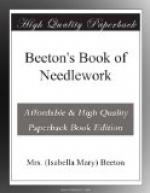Materials required: One frame of wire covered with silk ribbon; one square of Mecklenburg thread net (fillet), either coarse or fine; Mecklenburg thread; netting-needles and meshes of various sizes.
The netted foundation, or “fillet,” upon which this elegant work is embroidered, can be made by ladies very easily, and at much less cost than when bought ready made.
The square is worked by netting with coarse No. 2 or fine No.10 thread over a mesh measuring three-quarters of an inch or more, in rows backwards and forwards. Begin with 2 stitches, and increase 1 at the end of every row till you have one more stitch than is required for the number of holes. Thus, if a square of 26 holes is required, continue to increase up to 27 stitches, then decrease 1 at the end of every row till 2 stitches only remain. The last 2 stitches are knotted together without forming a fresh stitch.
The completed foundation is laced upon the frame, taking the lacing cotton through the double edge formed by the increased and decreased stitches. If the four corners of the netting are tied at each corner of the frame before beginning the lacing, that operation is greatly facilitated. The netting should be laced as tightly as possible, it being far easier to darn on than when loose.
[Illustration: 503.—Frame for Guipure d’Art.]
Ladies who wish to excel in working guipure d’art should practise each of the stitches until they attain perfect regularity and quickness in their execution. Two or three hours devoted to this in the first instance will not be time wasted, as the most elaborate pattern will be worked with ease as soon as the stitches are mastered.
The Mecklenburg thread of Messrs. Walter Evans and Co., of Derby, will be found a better colour than any other, as it closely resembles the shade of the ancient guipure lace.
It is sold only in spools of 200 yards each, and the numbers run as follow; No. 2, 4, 6, 8, lo, 12, 16, 20; No. 2 being the coarsest, and No. 20 the finest.
The principal stitches used in guipure d’art are POINT D’ESPRIT, POINT DE TOILE, POINT DE FESTON, POINT DE REPRISE, POINT DE BRUXELLES, and WHEELS and STARS. POINT D’ESPRIT is worked with finer cotton than the foundation, say No. 10 on a foundation of No. 6. It consists of a succession of small loops, as will be seen clearly in the illustration. The learner should begin from the mark * No. 503, and working a row of loops the length required, turn the frame and work loops on the opposite half of each square intersecting the first worked loops in the centre of each intervening bar of netting. A careful examination of Nos. 503 and 506 will explain this more clearly than is possible in words.
* * * * *
[Illustration: 504.—Point d’Esprit.]
POINT DE TOILE, or LINEN STITCH, is plain darning under and over each thread; this forms a fine close groundwork, and is much used in guipure d’art. Care should be taken to keep the same number of stitches in each square, both along and across; the number of threads shown in illustration No. 504 is 4 only, but 6 and even 8 are used in many netted foundations in fine patterns.




